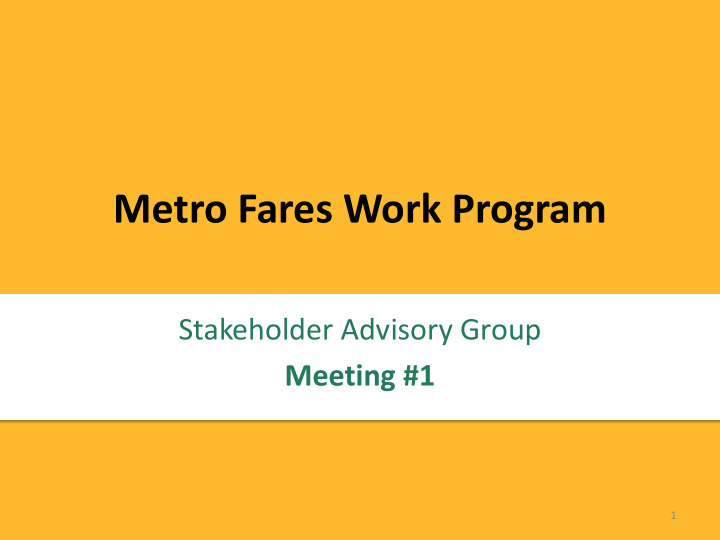



Metro Fares Work Program Stakeholder Advisory Group Meeting #1 1
Introductions and Overview Purpose • Two-year program • Assess ways to improve Metro’s fare structure • Guided by existing fare policy, farebox recovery targets 2
Introductions and Overview Goals • Make fares easier to understand and pay • Coordinate with regional partners • Improve safety • Speed operations by making fare payment faster • Increase transit ridership and address affordability barriers 3
Introductions 4
Introductions and Overview Agenda for today • Review work program scope and timeline • Review/discuss existing fare system • Discuss shared goals and criteria for evaluating proposals • Next steps 5
Stakeholder Advisory Group Work Role of this group • Serve in advisory capacity • Shape proposed fare changes in near-term • Identify outstanding needs/opportunities for longer-term work • Help support/facilitate public interest and engagement • Provide a broad range of perspectives 6
Stakeholder Advisory Group Work Timeline March May • Meeting #1 - Introductions • Meeting #3 – Refining options • Metro, Executive review proposal • Public engagement Phase 1 June April • Communicate proposal to • Meeting #2 – Reviewing options stakeholders and public • Public engagement Phase 2 • Executive transmits proposal to • Draft proposal King County Council 7
Stakeholder Advisory Group Work Scope of our work Near-term: 2017 Topic Work Elements Advisory Group Role Regional Fare Consider eliminating Provide input on options for making Forum certain fare surcharges these changes recommendations (peak/zone fares) Transit ridership Understand and Provide input on options for pilot or and affordability address barriers to demonstration projects that could be transit use done within existing policy (identify key barriers, consider design options, and identify potential impacts) Identify long-term TBD Identify other fares issues for scope consideration in the longer-term scope of work 8
Stakeholder Advisory Group Work Scope of our work Longer-term: 2018 Topic Work Elements Advisory Group Role Speeding Study options for increasing ORCA Potentially re-convene to boarding & market share and allowing payment provide input on options improving safety off-board or at all doors Transit ridership Based on findings from near-term Potentially re-convene to and affordability pilots and additional research, provide input on options develop proposals for programs or changes that address barriers to transit use 9
Existing conditions Existing conditions: current fares Off-peak One-zone Two-zone Monthly peak peak pass Regular fare $2.50 $2.75 $3.25 $90/$99/$117 Child (five years and under) No charge Youth (six through 18) $54 $1.50 $36 Seniors and persons with disabilities $1.00 $54 ORCA LIFT (low-income adult) $1.50 $63 ACCESS $1.75 Variable based on distance and number of days traveled. In 2016 Vanpool the average vanpool fare was $104.50 per month. • Zone boundary = Seattle city limits (customers taking trips that cross this boundary during peak hours pay 2-zone fare) • Peak hours: 6-9 a.m., 3-6 p.m. 10
Existing conditions How riders pay fares • One-third of riders use ORCA E-Purse ORCA PugetPass (Retail) an employer pass ORCA Puget Pass (Employer) ORCA Passport Pass (Employer) Cash • Frequent riders are 4 Nonpayment times more likely to 7% 16% pay with ORCA • One-sixth of riders use 29% 16% an RRFP* pass 3% 29% * Regional Reduced Fare Permit 11
Existing conditions How do the discounts we provide today affect fare revenues? Estimated retail value of • Metro currently discounted fares, 2016 provides over (in millions) Youth compared $27 million in to $2.50 $4.2 discounted ORCA LIFT $7.5 fares* compared to $2.50 $2.7 Sr/Disabled • About 15% of compared to $2.50 total fare Human service $3.4 tickets compared revenue to no subsidy Access fare $9.1 compared to federal maximum 12
Existing conditions What we’ve heard • Fare system is too complicated, especially if you use multiple modes or transit agencies • People want discounts for a variety of reasons – equity, promotional, to encourage institutional participation • Getting cards and adding value pose limitations, especially for reduced-fare customers • Concern about traveling short distances across two zones • Access, alternative services, and regular bus fare systems don’t “play well” together • What are we missing? 13
Exercise: values and evaluation criteria What guides our work? (Facilitated activity) • Policy goals – Regional coordination – Safety – Operational efficiency – Increase ridership – Easy for customers to – Reflect cost of service understand – Meet cost recovery targets – Reduce costs – Comply with regulations – Improve affordability for customers with low incomes • Additional goals or considerations? • How should we evaluate options? 14
Next steps Public engagement March April May June Advisory Group Advisory Group Advisory Group Transmit proposal Meeting #1 (focus Meeting #2 (focus Meeting #3 (focus to King County on introduction) on reviewing on refining Council options) options) Initial public outreach Second phase of Metro review of public outreach proposal Draft proposal Communicate final proposal to stakeholders and the public 15
Recommend
More recommend